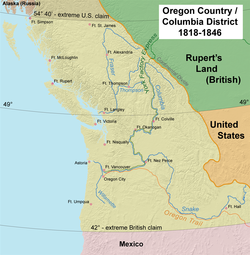
Back Kolumbia Distrikto Esperanto District du Columbia French Distretto di Columbia (1810-1846) Italian Columbia District Dutch Distrito de Colúmbia (América do Norte Britânica) Portuguese Колумбия (округ, Британская Северная Америка) Russian Columbia District Swedish 哥倫比亞地區 Chinese
Columbia | |
|---|---|
Fur trading district | |
 Map of the Oregon Country "jointly occupied" by the United States and the United Kingdom; the Columbia Department at its greatest extent included areas far to the north and to the south. | |
| Country | British North America |

The Columbia District was a fur-trading district in the Pacific Northwest region of North America, in both the United States and British North America in the 19th century. Much of its territory overlapped with the temporarily jointly occupied and disputed Oregon Country. It was explored by the North West Company between 1793 and 1811 and established as an operating fur-trading district around 1810. The North West Company was absorbed into the Hudson's Bay Company (HBC) in 1821, under which the Columbia District became known as the Columbia Department. It was considered part of British North America and later became the brief first Colony of British Columbia (1858–1866) with the subsequent merger with the Colony of Vancouver Island (1849–1866) to form a larger second short-lived Colony of British Columbia (1866–1871). After protracted negotiations with British and Canadian authorities, the newly reorganized Province of British Columbia joined in 1871 with the new Canadian confederation of 1867 further east, as the western-most province of the now trans-continental Dominion of Canada. The Oregon Treaty of June 1846, signed in Washington, D.C., by the United States and the United Kingdom, marked the effective end of the old Hudson's Bay Company's jurisdiction of the former western Columbia District / Department on the Pacific coast, although the HBC still continues a mercantile commercial business into the 21st century.
